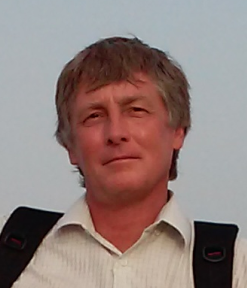Lecture on Zaitsev Neighborhood for Cellular Automata
Lecture on Zaitsev Neighborhood for Cellular Automata
A generalized neighborhood for d-dimensional cellular automata has been introduced by Dmitry Zaitsev in 2015. It spans the range from von Neumann's to Moore's neighborhood using a parameter which represents the dimension of hypercubes connecting neighboring cells. Finite hypercubes and hypertoruses are studied, and the number of neighbors on their boundary and the number of connections between cells are calculated. We come to finite constructs when practically implementing computations of cellular automata. Enumerations of cells, neighbors and connections are considered and implemented in ad-hoc software which generates a canvas of hypercube and hypertorus models in the form of a Petri net. A cell model can be replaced while the underlying canvas of connections remains the same. The generalized neighborhood is extended to include a concept of radius; the number of neighbors is calculated for infinite and finite lattices. For diamond-shaped neighborhoods, a sequence is obtained whose partial sums equal Delannoy numbers. Traditional application area is modeling networks, computing grids, and clouds. Promising application domains are opening in virology, epidemiology, and entomology for spreading viruses and insects, and corresponding deceases; material science for modeling cracks in life-critical constructs like planes and others.
Date and Time
Location
Hosts
Registration
-
 Add Event to Calendar
Add Event to Calendar
Loading virtual attendance info...
- Contact Event Host
-
Rohit Sharma
rohitapece@gmail.com
- Co-sponsored by Rohit Sharma
Speakers
 Dmitry A. Zaitsev of Odessa State Environmental University, Ukraine
Dmitry A. Zaitsev of Odessa State Environmental University, Ukraine
Zaitsev Neighborhood for Cellular Automata
A generalized neighborhood for d-dimensional cellular automata has been introduced by Dmitry Zaitsev in 2015. It spans the range from von Neumann's to Moore's neighborhood using a parameter which represents the dimension of hypercubes connecting neighboring cells. Finite hypercubes and hypertoruses are studied, and the number of neighbors on their boundary and the number of connections between cells are calculated. We come to finite constructs when practically implementing computations of cellular automata. Enumerations of cells, neighbors and connections are considered and implemented in ad-hoc software which generates a canvas of hypercube and hypertorus models in the form of a Petri net. A cell model can be replaced while the underlying canvas of connections remains the same. The generalized neighborhood is extended to include a concept of radius; the number of neighbors is calculated for infinite and finite lattices. For diamond-shaped neighborhoods, a sequence is obtained whose partial sums equal Delannoy numbers. Traditional application area is modeling networks, computing grids, and clouds. Promising application domains are opening in virology, epidemiology, and entomology for spreading viruses and insects, and corresponding deceases; material science for modeling cracks in life-critical constructs like planes and others.
Biography:
Dmitry A. Zaitsev received the Eng. degree in Applied Mathematics from Donetsk Polytechnic Institute, Donetsk, Ukraine, in 1986, the Ph.D. degree in Automated Control from the Kiev Institute of Cybernetics, Kiev, Ukraine, in 1991, and the Dr.Sc. degree in Telecommunications from the Odessa National Academy of Telecommunications, Odessa, Ukraine, in 2006. He is a Professor of Information Technology at Odessa State Environmental University, Ukraine since 2019. He developed the analysis of infinite Petri nets with regular structure, the decomposition of Petri nets in clans, generalized neighborhood for cellular automata, and the method of synthesis of fuzzy logic function given by tables. He developed Opera-Topaz software for manufacture operative planning and control; a new stack of networking protocols E6 and its implementation within Linux kernel; Petri net analysis software Deborah, Adriana, and ParAd; models of TCP, BGP, IOTP protocols, Ethernet, IP, MPLS, PBB, and Bluetooth networks. His current research interests include Petri net theory and its application in networking, computing and automated manufacture. Recently he started working in the area of exascale computing applying his theory of clans to speed-up solving sparse linear systems on parallel and distributed architectures. He was a co-director of joint projects with China and Austria. Recently he has been a visiting professor to Technical University of Dortmund, Germany on DAAD scholarship, to University of Tennessee Knoxville, USA on Fulbright scholarship and to Eindhoven University of Technology, Netherlands. He published a monograph, 3 book chapters and more than a hundred of papers including issues listed in JCR. He is a senior member of ACM and IEEE. Additional information including papers, software, models, video-lectures in put on personal web-site http://daze.ho.ua
Agenda
Understand the present day innovations in the Cellular Automata and Telecommunication Engineering sector which evolved from the conventional form and is moving towards future expansions.
Zaitsev Neighborhood for Cellular Automata

